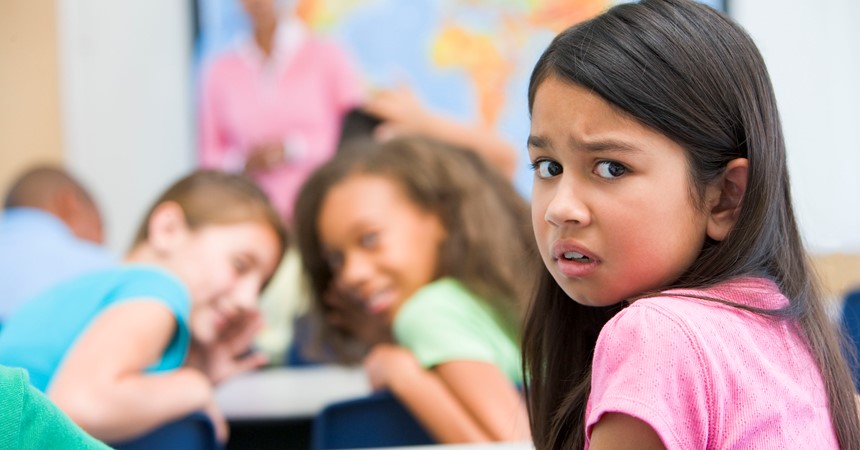School bullying is an issue of significant concern to parents, schools and young people themselves. Bullying occurs when a student or group of students targets an individual aggressively and repeatedly with the intention of causing harm, and the individual is unable to defend him/herself or stop the bullying (Hemphill, Heerde, & Gomo, 2014). Bullying behaviour can take various forms, including physical aggression (hitting, pushing), verbal teasing, damage to possessions, rumour-spreading, social exclusion and ‘cyberbullying’.
Cyberbullying is a particularly damaging form of bullying that occurs when an individual or group uses information and communication technologies to victimise others, such as by sending nasty or threatening messages via the internet or mobile phones, sharing others’ images or messages without permission, deliberately excluding others online and impersonating others to hurt or embarrass them.
While the prevalence of bullying varies internationally, around a quarter of young people are thought to be actively engaged in bullying others, are themselves victimised, or both (Juvonen & Graham, 2014). Some young people are targeted very frequently; in Australia, a national study revealed that 1 in 4 school students (in Years 4-9) reports being victimised every few weeks or more often (Cross et al, 2009). Nine per cent reported bullying others frequently and four per cent reported both being bullied and bullying others. Hurtful teasing is particularly common among this age group. The study also indicated that bullying tends to peak in times of school transition (eg transition to secondary school) and the experience of cyberbullying is more likely in secondary school. Approximately 7 per cent of students aged 8-14 years report being frequently cyberbullied (every few weeks or more often) and 3.5 per cent of Australian students report frequently cyberbullying others (every few weeks or more often) (Cross et al, 2009).
Those who are victimised by bullying behaviours are at increased risk of a range of negative emotional, social, academic and psychosomatic outcomes, including increased symptoms of anxiety and depression, increased loneliness, poorer academic engagement and achievement and poorer physical health (Gini & Pozzoli, 2013; Hase, Goldberg, Smith, Stuck, & Campain, 2015; Hemphill et al, 2011; Hinduja & Patchin, 2010; Kowalski & Limber, 2013; Smokowski, Evans, & Cotter, 2014; Sourander et al., 2010). These consequences can affect health and wellbeing on a long-term basis, and bullying is harmful both for those who are targeted and those who bully others (Ttofi, Farrington, Lösel & Loeber, 2011; Wolke, Copeland, Angold, & Costello, 2013).
Dealing with bullying
Children and adolescents are often reluctant to report bullying experiences to their parents or teachers, for fear that adults will make the situation worse (Cross et al, 2009). Young people should therefore be encouraged to tell a parent, teacher, or trusted adult and ask for their help to resolve bullying experiences. Adults should be careful not to overreact, but instead work with the young person and the school to resolve the situation. Retaliating or bullying in return may make the situation worse, and is harmful for both the person who is bullying and the person who has been bullied.
One of the most effective ways to stop bullying behaviours is when peer groups make it clear that bullying is not acceptable. Those who witness bullying can play a positive or negative role in the situation – doing nothing may allow the person bullying to think their behaviour is acceptable. Peer bystanders should be encouraged to intervene, stand up for the person being bullied or tell a teacher or adult what happened.
There are many websites that can offer more help and advice to those who experience bullying and cyberbullying, as well as their teachers and families, including Bullying no way and esafety. There are also free and confidential helplines that can be called or accessed online, such as Kids Helpline.
School bullying prevention
The most effective interventions to reduce harms associated with school bullying have typically involved multi-level strategies, targeting all members of the school community including students, their parents and families, teachers and other school staff (Ttofi & Farrington, 2009; Vreeman & Carroll, 2007). These interventions develop a school ethos that discourages bullying through school practices and policies, the school curriculum, professional development for staff, involvement of families and improving school physical and social environments.
For example, the Friendly Schools Plus program was developed by Australian researchers to be used in Australian primary and secondary schools. The program involves information and activities that can be used by the whole school environment, including students, teachers and parents. The program has been adopted by thousands of schools throughout Australia and internationally.
Please visit Telethon Kids.
References
Cross, D., Shaw, T., Hearn, L., Epstein, M., Monks, H., Lester, L., & Thomas, L. (2009). Australian Covert Bullying Prevalence Study (ACBPS). Retrieved from Western Australia:
Gini, G., & Pozzoli, T. (2013). Bullied children and psychosomatic problems: A meta-analysis. Pediatrics, 132, 720-729. doi:10.1542/peds.2013-0614
Hase, C. N., Goldberg, S. B., Smith, D., Stuck, A., & Campain, J. (2015). Impacts of traditional bullying and cyberbullying on the mental health of middle school and high school students. Psychology in the Schools, 52(6), 607-617.
Hemphill, S. A., Heerde, J. A., & Gomo, R. (2014). A conceptual definition of school-based bullying for the Australian research and academic community. Retrieved from Canberra:
Hemphill, S. A., Kotevski, A., Herrenkohl, T. I., Bond, L., Kim, M. J., Toumbourou, J. W., & Catalano, R. F. (2011). Longitudinal consequences of adolescent bullying perpetration and victimisation: A study of students in Victoria, Australia. Criminal Behaviour and Mental Health, 21, 107-116.
Hinduja, S., & Patchin, J. W. (2010). Bullying, cyberbullying, and suicide. Archives of Suicide Research, 14(3), 206-221.
Juvonen, J., & Graham, S. (2014). Bullying in schools: The power of bullies and the plight of victims. Annual Review of Psychology, 65, 159-185. doi:0.1186/1471-2458-12-494
Kowalski, R. M., & Limber, S. P. (2013). Psychological, physical, and academic correlates of cyberbullying and traditional bullying. Journal of Adolescent Health, 53, S13-S20. doi:10.1016/j.jadohealth.2012.09.018
Smokowski, P. R., Evans, C. B., & Cotter, K. L. (2014). The differential impacts of episodic, chronic, and cumulative physical bullying and cyberbullying: The effects of victimization on the school experiences, social support, and mental health of rural adolescents. Violence and victims, 29(6), 1029-1046.
Sourander, A., Brunstein Klomek, A., Ikonen, M., Lindroos, J., Luntamo, T., Koskelainen, M., . . . Helenius, H. (2010). Psychosocial risk factors associated with cyberbullying among adolescents: a population-based study. Archives of general psychiatry, 67(7), 720-728.
Ttofi, M., & Farrington, D. (2009). What works in preventing bullying: Effective elements of anti-bullying programes. Journal of Aggression, Conflict and Peace Research, 1(1), 13-24. doi:10.1108/17596599200900003
Ttofi, M. M., Farrington, D. P., Lösel, F., & Loeber, R. (2011). Do the victims of school bullies tend to become depressed later in life? A systematic review and meta-analysis of longitudinal studies. Journal of Aggression, Conflict and Peace Research, 3, 63-73. doi:10.1108/17596591111132873
Vreeman, R. C., & Carroll, A. E. (2007). A systematic review of school-based interventions to prevent bullying. Archives of Pediatrics & Adolescent Medicine, 161, 78-88. doi:10.1001/archpedi.161.1.78
Wolke, D., Copeland, W. E., Angold, A., & Costello, E. J. (2013). Impact of bullying in childhood on adult health, wealth, crime, and social outcomes. Psychological Science, 24, 1958-1970. doi:10.1177/0956797613481608























































































